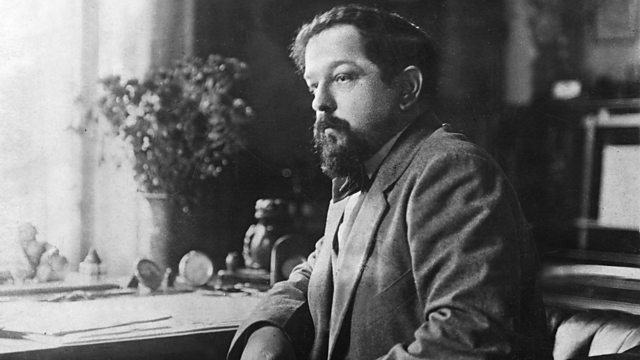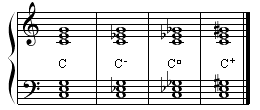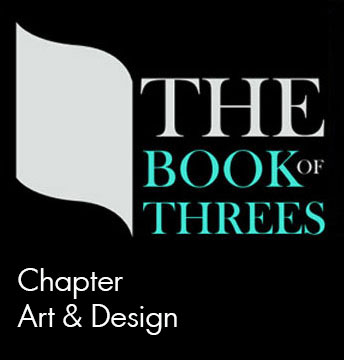

n.
- Music. A combination of three or more pitches sounded simultaneously.
- Harmony, as of color.
v., chord·ed, chord·ing, chords. v.intr.
- To be in accord; agree.
- Music. To play chords on an instrument.
v.tr.
- Music. To play chords on.
- To harmonize.
In tonal music the fundamental chord is called the triad. It consists of three pitches, two a perfect fifth apart and a third pitch a major or minor third lower, forming respectively the major or minor triad. However, a triad may instead be diminished or augmented, or may contain dissonant elements such as a seventh. In atonal music, other types of chord formations occur. It is, however, an essential property of a chord that it be conceived as an entity, that its constituent notes “fuse” rather than merely coincide in time.
The most frequently encountered chords are triads, so called because they consist of three distinct notes: further notes may be added to give seventh chords, extended chords, or added tone chords. The most common chords are the major and minor triads and then the augmented and diminished triads. The descriptions “major”, “minor”, “augmented” and “diminished” are sometimes referred to collectively as chordal “quality”. Chords are also commonly classed by their root note so, for instance, the chord C Major may be described as a triad of major quality built upon the note C. Chords may also be classified by inversion, the order in which their notes are stacked.
Definition and history

Mussorgsky’s Pictures at an Exhibition “Promenade”, is a piece showing an explicit chord progression.(Nattiez 1990, p. 218)

- Chapters
- descriptions off, selected
- captions settings, opens captions settings dialog
- captions off, selected
This is a modal window.
Beginning of dialog window. Escape will cancel and close the window.
End of dialog window.
The English word “chord” derives from Middle English “cord”, a shortening of “accord” in the original sense of “agreement” and later “harmonious sound”. A sequence of chords is known as a chord progression or harmonic progression. These are frequently used in Western music. A chord progression “aims for a definite goal” of establishing (or contradicting) a tonality founded on a key, root or tonic chord. The study of harmony involves chords and chord progressions, and the principles of connection that govern them.
Otto Karolyi writes that “two or more notes sounded simultaneously are known as a chord” though, since instances of any given note in different octaves may be taken as the same note, it is more precise for the purposes of analysis to speak of distinct “pitch classes”. Furthermore, as three notes are needed to define any common chord, three is often taken as the minimum number of notes that form a definite chord. Hence Andrew Surmani, for example, (2004, p. 72) states; “when three or more notes are sounded together, the combination is called a chord” and George T. Jones (1994, p. 43) agrees; “two tones sounding together are usually termed an interval, while three or mores tones are called a chord“. According to Monath (1984, p. 37); “A chord is a combination of three or more tones sounded simultaneously” and the distances between the tones are called intervals. However sonorities of two pitches, or even single-note melodies, are commonly heard as “implying” chords.
For a sound configuration to be recognized as a chord it must have a certain duration. But, since a chord may be understood as such even when all its notes are not simultaneously audible, there has been some academic discussion regarding the point at which a group of notes may be called a chord. Jean-Jacques Nattiez (1990, p. 218) explains that “we can encounter ‘pure chords’ in a musical work,” such as in the “Promenade” of Modest Mussorgsky‘s Pictures at an Exhibition but “often, we must go from a textual given to a more abstract representation of the chords being used” – as in Claude Debussy’s Première Arabesque.

Upper stave: Claude Debussy‘s Première Arabesque. The chords on the lower stave are constructed from the notes in the actual piece, shown on the upper stave.

- Chapters
- descriptions off, selected
- captions settings, opens captions settings dialog
- captions off, selected
This is a modal window.
Beginning of dialog window. Escape will cancel and close the window.
End of dialog window.
In the medieval era, early Christian hymns featured organum (which used the simultaneous perfect intervals of a fourth, a fifth, and an octave), with chord progressions and harmony an incidental result of the emphasis on melodic lines during the medieval and then Renaissance (15-17th centuries).
The Baroque period, the 17th and 18th centuries, began to feature the major and minor scale based tonal system and harmony, including chord progressions and circle progressions. It was in the Baroque period that the accompaniment of melodies with chords was developed, as in figured bass, and the familiar cadences (perfect authentic, etc.). In the Renaissance, “certain dissonant sonorities that suggest the dominant seventh occurred with some frequency.” In the Baroque the dominant seventh proper was introduced and it was in constant use in the Classical and Romantic periods. The leading-tone seventh began to be used in the Baroque and continues. Nondominant seventh chords began to be used in the Baroque period, became frequent in the Classical, began to give way to altered dominantss in the Romantic period, and underwent a resurgence in the Post-Romantic and Impressionistic period.
The Romantic period, the 19th century, featured increased chromaticism. Secondary dominants began to be used in the Baroque, becoming very common in the Romantic period. Many contemporary popular Western genres continue to be founded in simple diatonic harmony, though far from universally: notable exceptions include the music of film scores, which often use chromatic, atonal or post-tonal harmony, and modern jazz (especially circa 1960), in which chords may include up to seven notes (and occasionally more).
Triads consist of three notes; the “root” or “first” note, the “third” and the “fifth”. For example the C major scale consists of the notes C D E F G A B: a triad can be constructed on any note of such a major scale and all will be minor or major except the triad on the seventh or leading-tone which is a diminished chord. A triad formed using the note C itself consists of C, the root note, E (the third note of the scale) and G (the fifth note of the scale). The interval from C to E is of four semitones, a major third, and so this triad is called C Major. A triad formed upon the same scale but with D as the root note, D (root), F (third), A (fifth), on the other hand, has only three semitones between the root and third and is called D minor, a minor triad.
Read more: http://www.answers.com/topic/chord-1#ixzz1aKorIKQv
Read more: http://www.answers.com/topic/chord-1#ixzz1aKob19JI
Share this:
- Click to share on Facebook (Opens in new window)
- Click to share on Twitter (Opens in new window)
- Click to share on LinkedIn (Opens in new window)
- Click to share on Pinterest (Opens in new window)
- Click to share on Tumblr (Opens in new window)
- Click to share on Reddit (Opens in new window)
- Click to email a link to a friend (Opens in new window)
- Click to print (Opens in new window)
- Click to share on Telegram (Opens in new window)
- Click to share on WhatsApp (Opens in new window)
- Click to share on Pocket (Opens in new window)






























